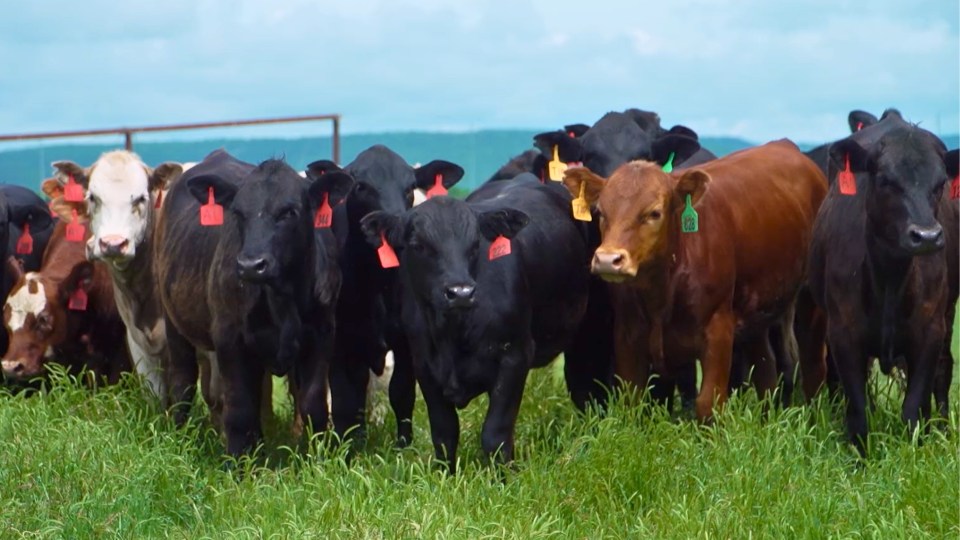How internal parasites impact
cattle immunity and vaccine efficacy
By Dr. Grant Crawford
Most cattle producers associate internal parasites with a reduction in feed intake. Indeed, the No. 1 effect of internal parasites is a decreased appetite, which means there are fewer nutrients for an animal to absorb. On top of that, internal parasites have a direct effect on nutrition absorption because they cause inflammation in the gut.
This reduction in nutrient intake and absorption is detrimental to all cattle but especially highly stressed animals. They typically already have lower feed intake without the added stress of an internal parasite challenge.

Internal parasites affect the nutritional status of the animal in three ways: They decrease feed intake, they decrease nutrient absorption and they increase nutrient requirements. These effects of internal parasite infections on the animal’s nutritional status are important because they impact and compromise every aspect of biology — including growth, milk production, immune function and reproduction.
Cattle producers put a lot of effort and resources into vaccinating their cattle and offering high-quality feed and mineral programs. These efforts and resources are not fully utilized and can be wasted if cattle are parasitized.
Even a low number of internal parasites can affect cattle health and performance. Cattle with relatively low parasite burdens (324 total slaughter worm counts) have been shown to have depressions in feed intake of up to 3.2%, while cattle with high parasite burdens (11,164 total slaughter worm counts) have been shown to have depressions in feed intake of up to 7.8%.1,2
Impact on the immune system
Internal parasitic worms burrow into the animal’s gastric glands and damage the gut lining. This causes the immune system to react and put its effort toward fighting the threat.
Th1 and Th2 — both types of helper cells — play an important role in immunity. The Th1 response is the immune system’s response to a viral or intracellular infection. A Th2 response is not necessarily specific to parasites but commonly associated with them. A Th2 response can block a Th1 response.
If there’s enough of a worm burden that a Th2 immune response occurs, the immune system will focus almost solely on trying to get rid of the parasites and will not be able to handle an intracellular invader like coccidiosis, pinkeye or another type of viral outbreak. It predisposes cattle to attacks from viruses, and, of course, viruses can open the door to bacterial infections.
Younger animals, such as suckling calves, weaned calves, replacement heifers or stocker cattle, are much more susceptible to parasites because they don’t have any immunity built up against them. This will develop as an animal gets older, but cattle are never fully immune to parasites.
Deworming prior to vaccination
In much the same way as a virus does, a modified live five-way vaccine is ideally going to trigger a Th1 response. If cattle are parasitized and a Th2 response is triggered, this can impact the animal’s ability to positively respond to the vaccine.
Vaccine labels say “effective for the vaccination of healthy cattle.” It is important to deworm cattle ideally one to two weeks prior to vaccination and give them time for their immune system to respond.
Several studies have demonstrated the benefits of proper deworming on the health status of an animal. Research shows that calves dewormed two weeks pre-vaccination maintained lower rectal temperatures following an IBR challenge than those dewormed at vaccination or not dewormed at all.3 This means they were better able to withstand the disease challenge than those who had not been dewormed.
An Oklahoma trial compared the effects of deworming calves on pasture during the suckling phase and after weaning in the stocker phase.1 Morbidity was highest in cattle that were never dewormed, and lowest in cattle that were dewormed in both phases. Additionally, cattle that were never dewormed were treated more times for respiratory disease than those that were dewormed in either or both phases.
Summer deworming can be easy
Deworming cattle ahead of vaccination doesn’t have to mean a trip through the chute or be labor intensive. Using feed and mineral forms of dewormers — such as range cubes, dewormer blocks or mineral — require relatively little time and labor and are highly effective.
This is important to consider, especially midsummer. If dewormed at turnout, cattle will start picking up parasites almost immediately once they are on green grass, and those parasites can start doing damage almost immediately. If cattle are not dewormed until they come off the pasture in the fall, they have several months of picking up worms and damaging their gut.
It also is important to deworm calves at cow side. At about six to eight weeks of age, calves start ruminating and are at high risk of internal worms. Deworming at earlier stages of infection can result in improved weaning weights. For spring calving herds, it typically is good to deworm calves six to eight weeks after turnout onto pasture.4
Parasite control best practices
There is not always a visual sign of parasitism. After deworming, we often don’t know how effective the deworming was and the amount of time before reinfestation occurs.
A fecal egg count reduction test (FECRT) is the standardized diagnostic tool to test manure for the presence of internal parasites’ eggs. It is important that 20 samples are taken both at treatment and 14 days post-treatment. A successful deworming should result in a 90% or greater reduction in parasite eggs in feces.5
Ask your Merck Animal Health representative for a free FECRT kit. Work with your veterinarian and animal health representative to assess your deworming program and find the timing and formulations that work best for your operation.
References
- Smith, R. A., Rogers, K. C., Huse, S., Wray, M. I., Brandt, R. T., Hutcheson, J. P., Nichols, W. T., Taylor, R. F., Rains, J. R., McCauley, C. T. Pasture deworming and (or) subsequent feedlot deworming with fenbendazole. I. Effects on grazing performance, feedlot performance and carcass traits of yearling steers. Bovine Pract. 2000. 34(2), 104-114.
- Taylor, R. F., Bliss, D. H., Brandt, Jr., R. T. , Nichols, W. T., Rains, J. R., Hutcheson, J. P. Smith, R. A. Pasture deworming and (or) subsequent feedlot deworming with fenbendazole. II. Effects on abomasal worm counts and abomasal pathology of yearling steers. Bovine Pract. 2000. 34:115-123.
- J. S. Schutz, J. A. Carroll, L. C. Gasbarre, T. A. Shelton, S. T. Nordstrom, J. P. Hutcheson, H. Van Campen, T. E. Engle. Effects of gastrointestinal parasites on parasite burden, rectal temperature, and antibody titer responses to vaccination and infectious bovine rhinotracheitis virus challenge. J. Ani. Sci. June 2012. 90(6)1948-1954. https://doi.org/10.2527/jas.2011-4059.
- Kevin Gould. Beef cattle deworming strategies. Michigan State University Extension. Jan. 21, 2022. https://www.canr.msu.edu/news/beef_cattle_deworming_strategies. Retrieved May 18, 2022, from https://www.canr.msu.edu/news/beef_cattle_deworming_strategies
- Dobson R., Jackson F., Levecke B., Besier B., et al. Guidelines for fecal egg count reduction tests (FECRT). World Association for the Advancement of Veterinary Parasitology (WAAVP). 2011 Proceedings: 23rd International Conference of the World Association for the Advancement of Veterinary Parasitology.
Find more content for your beef operation.
About the author

Grant Crawford, Ph.D.
Associate Director, Cattle Technical Services,
Merck Animal Health
